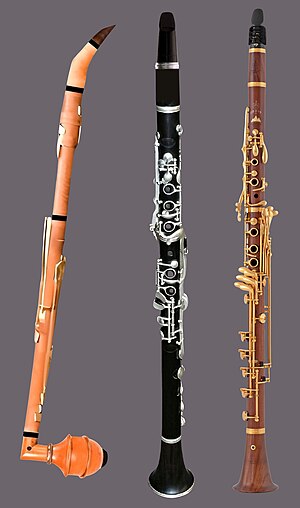
Back Basetový klarinet Czech Bassettklarinette German Bassettklarnet Estonian Clarinette de basset French Basetni klarinet Croatian Clarinetto di bassetto Italian バセットクラリネット Japanese Bassetklarinet Dutch 巴塞單簧管 Chinese
 Basset clarinet after Anton Stadler (replica), 1st modern basset clar. (1900–1950) German system, Basset clar. French System | |
| Woodwind musical instrument | |
|---|---|
| Other names | German: Bassettklarinette, French: clarinette de basset; Italian: clarinetto di bassetto; |
| Classification | Aerophon, clarinet-family |
| Inventor(s) | Theodor Lotz and others |
| Developed | around 1770 |
| Playing range | |
1.  2. 2.  1. written 2. basset clarinet in A, playing | |
| Related instruments | |
| clarinet, clarinet d'amore, alto clarinet, basset horn | |
| Musicians | |
| Sabine Meyer, Charles Neidich, Vlad Weverbergh, Sharon Kam, Martin Fröst, Shirley Brill | |
| Builders | |
| Leitner & Kraus (instrument top), Schwenk & Seggelke (instruments in the middle and below), Buffet Crampon, Backun Musical Services, Stephan Fox, FAU, Wurlitzer, Gerold-Clarinets | |

The basset clarinet is member of the clarinet family similar to the usual soprano clarinet but longer and with additional keys to enable playing several additional lower notes. Typically a basset clarinet has keywork going to a low (written) C or B,[1][2] as opposed to the standard clarinet's E or E♭. The basset clarinet is most commonly a transposing instrument in A, although basset clarinets in C and B♭ and very seldom in G also exist.[3] The similarly named basset horn is also a clarinet with extended lower range, but is in a lower pitch (typically F); the basset horn predates, and undoubtedly inspired, the basset clarinet.
- ^ Fox, Stephen. "Basset clarinet and basset conversion". Stephen Fox Clarinets. Archived from the original on 2018-12-23.
- ^ Rice, Albert R. (2016). "The Basset Clarinet: Instruments, Makers, and Patents". In Libin, L. (ed.). Instrumental odyssey: a tribute to Herbert Heyde. Hillsdale, New York: Pendragon Press. pp. 157–178. ISBN 978-1-57647-252-1. OCLC 932302591. Retrieved 2020-02-22.
- ^ Rice, Albert R. (2003). The clarinet in the classical period. Oxford: Oxford University Press. ISBN 978-0-19-534381-6. OCLC 57124590.